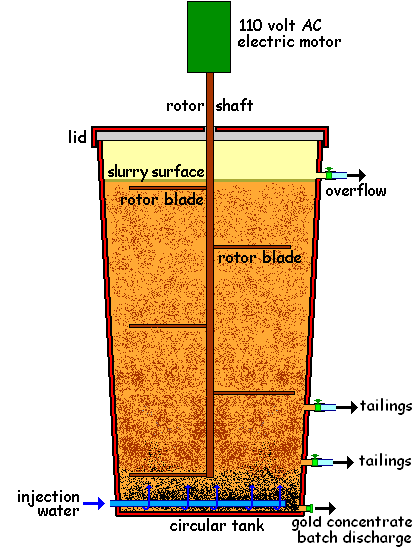Ever heard of the Pyramid Rotary Jig?, Its not a jig, its better than a jig... |


Ever heard of the Pyramid Rotary Jig?, Its not a jig, its better than a jig... |
 May 30 2007, 01:26 AM May 30 2007, 01:26 AM
Post
#1
|
|
|
Diggin' In!   Group: Members Posts: 26 Joined: 14-February 07 Member No.: 990 |
With Stickwhipper and other Alaska Gold Forum members, we would appreciate any help in tracing the whereabouts of this remarkable device - please read carefully:
 This advert is all we have to go on, and it is thought that production ceased in the early 1990s. Nobody we know has got one! Here is my doodle of what it MIGHT look like inside:  Its exciting as it is NOT a jig, as it lacks a jig screen, has no ragging, lacks a hutch, and lacks any vertical jigging motion! Instead the Pyramid Rotary Jig is a member of a special class of gravitational devices only recently recognised and this class seems particularly good at recovering fine gold. Here are my notes on what we think its all about... In the early 1990s Pyramid Industries of Santa Clara, California made the Pyramid ‘Rotary Jig’. Manufacture ceased and we traced neither inventor nor company. A company advert is the sole source of data. The device lacks jig screen, jig bed, ragging, hutch chamber or vertical jig motion. The advert stresses it differs from hutch jigs and diaphragm jigs. Rather the invention belongs to a family of gravitation devices termed ‘elutriated sludge tanks’ (E-tanks) that seem particularly suited to recovering very fine gold. The Pyramid ‘Rotary Jig’ is here renamed the ‘Pyramid E-tank’. Model #T50 consists of a circular tank tapering from 22-inch diameter at the top to 18-inch diameter at the bottom. The taper is said to be significant. Operation The tank is first filled with screened material – how much screening is unclear. When the tank is full of sediment, pressurised water injected from below – how much pressure is unclear. As with other E-tanks, little water is required. Water consumption varies with the gold size to be recovered – 2mm gold requires 2,725 litres/hour for a throughput of 4 tons of solids, down to very fine gold (<100 micron) requiring 454 litres/hour for a throughput of 0.9 tons, and for the finest gold 114 litres/hour for 0.5 tons of solids. Once the pressurized water is added, the stirrer blades are able to begin to rotate – how fast a rotation is unclear. The blades are simple metal bars welded at intervals along a central solid metal bar that acts as the drive axle turned by a 110-volt A.C. electric motor mounted above the tank. The device is innovative in slurrifying by rotary stirring. The gold and other heavy particles spiral down, while the lights spiral upward. This seems to be in thixotropic sludge-like slurry. After several minutes of operation, the barren tailings are bled through the tank wall via drain taps at two levels. Then the tank is refilled and the process repeated “over and over again” until an “ultra-rich concentrate” is achieved. A concentration ratio as large as 2000:1 is possible and the concentrate is removed from the bottom of the tank via a concentrate tap as a batch discharge. Continuous operation is possible with automatic feeders. Adoption by placer gold miners The device seems to have enjoyed a brief period of moderate interest from recreational miners in North America but then swiftly vanished into obscurity. It is unclear if any such devices are still in use in spite of their clear potential for fine gold recovery. |
|
|
|

 russau i dont think you could add to much material into t... May 30 2007, 04:42 AM
russau i dont think you could add to much material into t... May 30 2007, 04:42 AM
 Steppegold QUOTE (russau @ May 30 2007, 04:42 AM)i dont ... May 30 2007, 05:54 AM
Steppegold QUOTE (russau @ May 30 2007, 04:42 AM)i dont ... May 30 2007, 05:54 AM
 russau i understand that! but it is just a modifiacat... May 31 2007, 05:28 AM
russau i understand that! but it is just a modifiacat... May 31 2007, 05:28 AM
 Steppegold Russau - sure, right on the nail. The key perhaps ... May 31 2007, 02:09 PM
Steppegold Russau - sure, right on the nail. The key perhaps ... May 31 2007, 02:09 PM  |
| Lo-Fi Version | Time is now: 25th May 2025 - 10:13 AM |